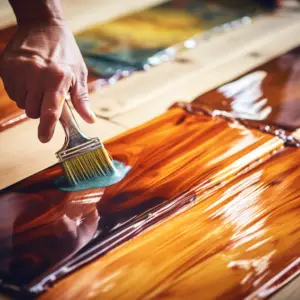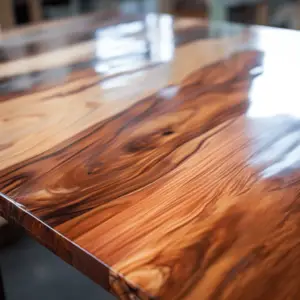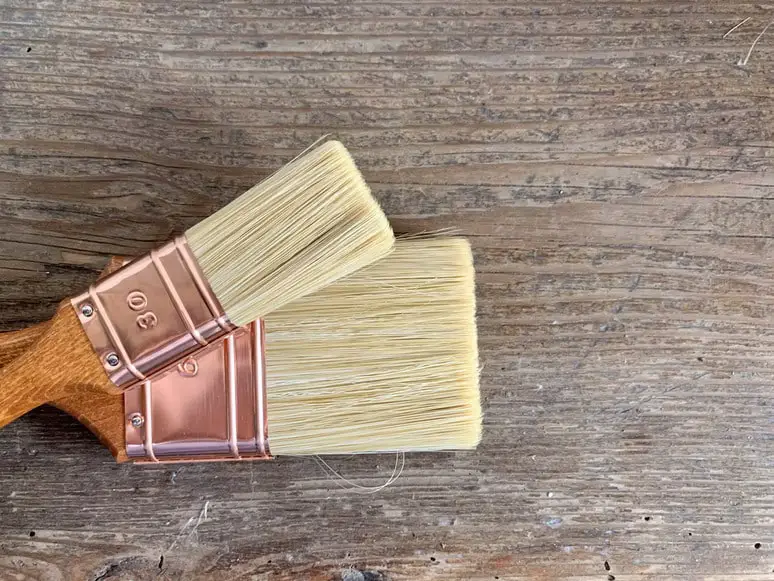Do you want to know the difference between epoxy vs. varnish? If you’re unsure you’re not alone, many people misconstrue them as being the same thing when in fact, they are different.
Here we will go over the main differences between these two types of coating so you can make an informed decision.
Table of Contents
What is Epoxy?

Epoxy, one of the most widely used wood finishes, is a chemical that hardens when exposed to air. When you apply it to wood, it sets up into a tough, waterproof finish that can be sanded after it’s dried.
In the past few years, epoxy has gained some serious traction in the woodworking community. Different formulations have been developed over the years, and they’re used as both undercoats and topcoats. Some people swear by them for their durability.
Epoxy comes in many forms, including gel, resin, resin-filled polymer, and resin-filled rubber. Each formula has its advantages and disadvantages. The type you choose depends on the material you’re repairing, the thickness of the layer needed to protect it, the lifespan of the repair, your tolerance for solvent fumes, and what materials will make up the final substrate.
What is Varnish?
Varnish is a clear, liquid coating that you can use to protect wood from water damage, dust, or stains. It should be applied after the wood dries completely and is completely cured. Varnish has both commercial and DIY versions.
Varnish comes in many forms, but the two most common are polyurethane and urethane. Polyurethane is what you see on plywood and other lightweight materials; urethane is on weather-proofing decks or on boats that get wet.
Epoxy vs. Varnish: What is the Difference?
Many people confuse one of these products with the other. In some cases, they use the word “epoxy” when what they really mean is “varnish.” To clear up any confusion, here are the main differences between varnish and epoxy.
Differences in Ingredients:
Varnish is made from drying oils (such as linseed or tung oil) which are polymerized over time through a chemical process called oxidation. Epoxy, on the other hand, is made from synthetic resins combined with a hardening agent such as a catalyst. When exposed to air, epoxies tend to dry faster than varnishes do. This means that you will have less time to work with the product before it sets on your work surface.
Differences in Application:
The differences between these two materials become apparent when you begin to apply them.
Epoxies are applied with a brush or roller, while varnishes may be applied using a sprayer for a smoother finish. While applying varnish, you must work quickly. Once it begins to cure, it dries rapidly and becomes too thick to spread evenly. To avoid this problem, you must use a thinner that evaporates quickly and keeps your finish smooth.
Epoxy also requires a solvent to keep it liquid during application, but it can take several hours to dry, so there is no need to rush through the process.
Differences in Finish:
Varnish is available in clear finishes, but with time and exposure to weather elements, it can turn yellow in color.
On the other hand, epoxy dries up clear and does not change color even if exposed to harsh climatic conditions for a long time.
Differences in Protection:
Varnish offers protection against fading caused by ultraviolet rays and light damage. It also protects wood against moisture and mildew.
Epoxy offers better protection against water damage than varnish because it won’t absorb water the way that varnish does. However, even the best epoxy won’t last as long as varnish when exposed to elements such as direct sunlight or high humidity levels over a long period.
Epoxy vs. varnish – Durability:
Durability is where epoxy stands out from varnish. Epoxy is a hard, durable resin.
Epoxy cures harder than varnish and provides a more durable finish. It provides better protection against water damage, resists scratches and chips better than varnish, making it ideal for boat decks and outdoor furniture.
Varnish will not set up as hard as epoxy, so it scratches easily. It does not resist impacts as well as epoxy, but it is easier to apply than epoxy. Varnish contains UV inhibitors that will not yellow in sunlight like epoxy can.
Epoxy vs. varnish – Cost:
Varnish is less expensive than epoxy. The latter also requires hardeners for it to be applied properly, so extra cost is involved in buying them as well.
What are the Pros and Cons of Epoxy vs. Varnish:
Advantages of Epoxy:
Epoxy coatings are resistant to impact damage and abrasions. They form a hard shell that protects the surface underneath from corrosion or damage. They’re easy to apply and can be customized with different colors to suit your tastes.
Disadvantages of Epoxy:
Epoxy coatings don’t adhere well to porous surfaces like wood or concrete without proper preparation (primers are required). They’re also flammable when wet, so care must be taken not to ignite them during application or curing time.
Pros of Varnish
Varnish does not require a primer and can be easily removed without damaging the underlying wood. A varnish finish on furniture keeps out moisture and stains much better than paint does, which makes it an ideal choice for outdoor furniture.
Most importantly, varnish provides a beautiful new look that matches or enhances the natural beauty of your piece of furniture.
Cons of Varnish:
While varnish can create a protective layer over the wood’s surface, it can still allow water damage to seep into it over time. The buildup of dirt in the pores makes the wood absorb moisture from any spills or splashes that may occur in your home. While this type of damage is not noticeable initially, it’s something to be mindful of because it could lead to rot later on.
Epoxy vs. varnish? Which One Should You Use?

Varnish can be applied to any wood surface for both aesthetic and functional purposes. Aesthetically, varnish brings out the natural beauty of the wood grain and color. Functionally, it provides a coating of protection against water damage, scratches, and other damage that could harm your furniture or other wooden items.
Expoxy is used to coat tables, chair legs, countertops, dressers, and more. You can also use it to seal cracks in wood furniture. You might even see epoxy used in art projects like painting rocks or covering tables with glitter!
Varnish is best for outdoor surfaces because it’s more resistant to extreme weather conditions than epoxy resin.
However, if you have an indoor surface that needs protection from scratches and water damage, then either product should work fine – just make sure to clean up any spills immediately so they don’t stain your flooring or countertops!


